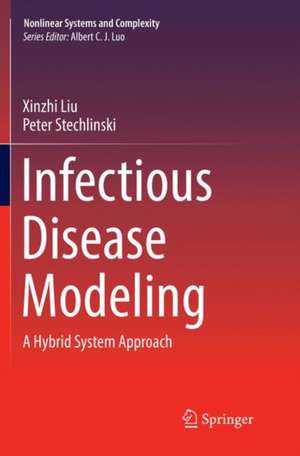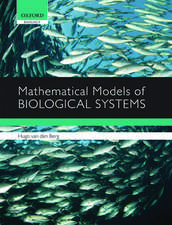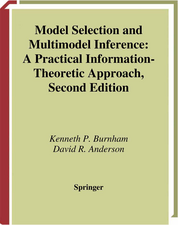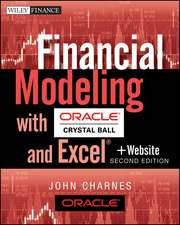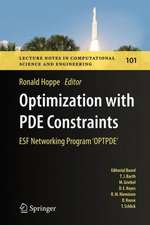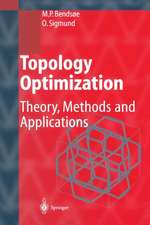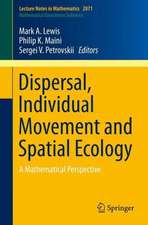Infectious Disease Modeling: A Hybrid System Approach: Nonlinear Systems and Complexity, cartea 19
Autor Xinzhi Liu, Peter Stechlinskien Limba Engleză Paperback – 21 iul 2018
| Toate formatele și edițiile | Preț | Express |
|---|---|---|
| Paperback (1) | 479.18 lei 38-44 zile | |
| Springer International Publishing – 21 iul 2018 | 479.18 lei 38-44 zile | |
| Hardback (1) | 739.00 lei 3-5 săpt. | |
| Springer International Publishing – 3 mar 2017 | 739.00 lei 3-5 săpt. |
Din seria Nonlinear Systems and Complexity
- 18%
 Preț: 739.00 lei
Preț: 739.00 lei - 15%
 Preț: 651.02 lei
Preț: 651.02 lei - 15%
 Preț: 644.82 lei
Preț: 644.82 lei - 24%
 Preț: 738.03 lei
Preț: 738.03 lei - 18%
 Preț: 1107.41 lei
Preț: 1107.41 lei - 18%
 Preț: 1390.26 lei
Preț: 1390.26 lei - 24%
 Preț: 801.70 lei
Preț: 801.70 lei - 15%
 Preț: 645.79 lei
Preț: 645.79 lei - 15%
 Preț: 643.48 lei
Preț: 643.48 lei - 15%
 Preț: 645.28 lei
Preț: 645.28 lei -
 Preț: 390.84 lei
Preț: 390.84 lei -
 Preț: 394.87 lei
Preț: 394.87 lei - 15%
 Preț: 642.36 lei
Preț: 642.36 lei - 15%
 Preț: 647.40 lei
Preț: 647.40 lei - 15%
 Preț: 647.59 lei
Preț: 647.59 lei - 18%
 Preț: 889.75 lei
Preț: 889.75 lei - 15%
 Preț: 648.05 lei
Preț: 648.05 lei - 20%
 Preț: 567.44 lei
Preț: 567.44 lei - 24%
 Preț: 738.97 lei
Preț: 738.97 lei - 18%
 Preț: 789.03 lei
Preț: 789.03 lei - 20%
 Preț: 449.32 lei
Preț: 449.32 lei - 24%
 Preț: 786.73 lei
Preț: 786.73 lei - 24%
 Preț: 932.04 lei
Preț: 932.04 lei - 24%
 Preț: 777.30 lei
Preț: 777.30 lei - 24%
 Preț: 779.77 lei
Preț: 779.77 lei - 18%
 Preț: 1118.93 lei
Preț: 1118.93 lei - 18%
 Preț: 1539.10 lei
Preț: 1539.10 lei - 18%
 Preț: 789.52 lei
Preț: 789.52 lei - 18%
 Preț: 897.95 lei
Preț: 897.95 lei - 15%
 Preț: 640.24 lei
Preț: 640.24 lei - 18%
 Preț: 951.29 lei
Preț: 951.29 lei
Preț: 479.18 lei
Preț vechi: 598.97 lei
-20% Nou
Puncte Express: 719
Preț estimativ în valută:
91.69€ • 99.91$ • 77.26£
91.69€ • 99.91$ • 77.26£
Carte tipărită la comandă
Livrare economică 19-25 aprilie
Preluare comenzi: 021 569.72.76
Specificații
ISBN-13: 9783319850900
ISBN-10: 3319850903
Pagini: 271
Ilustrații: XVI, 271 p. 72 illus., 67 illus. in color.
Dimensiuni: 155 x 235 mm
Ediția:Softcover reprint of the original 1st ed. 2017
Editura: Springer International Publishing
Colecția Springer
Seria Nonlinear Systems and Complexity
Locul publicării:Cham, Switzerland
ISBN-10: 3319850903
Pagini: 271
Ilustrații: XVI, 271 p. 72 illus., 67 illus. in color.
Dimensiuni: 155 x 235 mm
Ediția:Softcover reprint of the original 1st ed. 2017
Editura: Springer International Publishing
Colecția Springer
Seria Nonlinear Systems and Complexity
Locul publicării:Cham, Switzerland
Cuprins
Introduction.- Modelling the Spread of an Infectious Disease.- Hybrid Epidemic Models.- Control Strategies for Eradication.- Discussions and Conclusions.- References.- Appendix
Recenzii
“If you have a serious interest in the epidemiology of infectious diseases and are eager to roll up your sleeves, please consult this book … .” (Odo Diekmann, SIAM Review, Vol. 61 (1), March, 2019)
“This book focuses on infectious disease mathematical models, taking seasonality and changes in population behavior into account, using a switched and hybrid systems framework. … This book is strongly recommended to graduate level students with a background in dynamic system or epidemic modeling and an interest in mathematical biology, epidemic models, and physical problems exhibiting a mixture of continuous and discrete dynamics.” (Hemang B. Panchal, Doody’s Book Reviews, April, 2017)
“This book presents a new type of switched model for the spread of infectious diseases. … This book should be useful and attractive for students and researchers seeking updated progresses in the fieldof epidemic modeling … .” (Yilun Shang, zbMATH 1362.92002, 2017)“This book focuses on infectious disease mathematical models, taking seasonality and changes in population behavior into account, using a switched and hybrid systems framework. … This book is strongly recommended to graduate level students with a background in dynamic system or epidemic modeling and an interest in mathematical biology, epidemic models, and physical problems exhibiting a mixture of continuous and discrete dynamics.” (Hemang B. Panchal, Doody’s Book Reviews, April, 2017)
Notă biografică
Xinzhi Liu is a Professor of Mathematics at the University of Waterloo. Peter Stechlinski is a Postdoctoral Fellow in the Process Systems Engineering Laboratory at the Massachusetts Institute of Technology
Textul de pe ultima copertă
This volume presents infectious diseases modeled mathematically, taking seasonality and changes in population behavior into account, using a switched and hybrid systems framework. The scope of coverage includes background on mathematical epidemiology, including classical formulations and results; a motivation for seasonal effects and changes in population behavior, an investigation into term-time forced epidemic models with switching parameters, and a detailed account of several different control strategies. The main goal is to study these models theoretically and to establish conditions under which eradication or persistence of the disease is guaranteed. In doing so, the long-term behavior of the models is determined through mathematical techniques from switched systems theory. Numerical simulations are also given to augment and illustrate the theoretical results and to help study the efficacy of the control schemes.
Caracteristici
Imparts a quantitative understanding of the roles seasonality and population behavior play in the spread of a disease; Illustrates formulation and theoretical analysis of mathematical disease models and control strategies; Investigates how abrupt changes in the model parameters or function forms affect control schemes; Explains techniques from switched and hybrid systems applicable to disease models as well as many other important applications in mathematics, engineering, and computer science; Adopts a treatment accessible to individuals with a background in dynamic systems or with a background in epidemic modeling.
